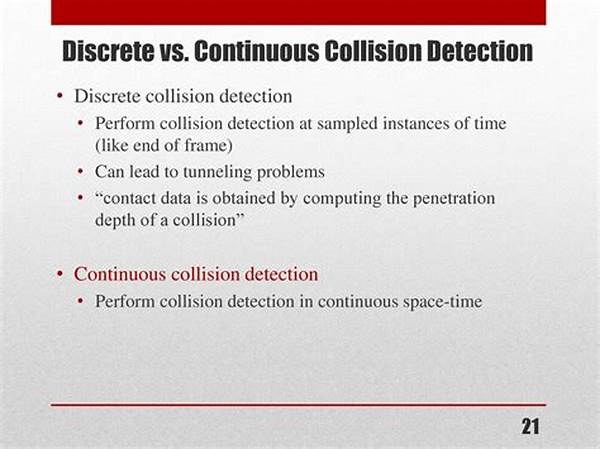Hey there, fellow tech enthusiasts! Today, we’re diving into the fascinating world of game physics with a focus on a crucial topic: “continuous versus discrete collision detection.” Whether you’re a budding game developer or simply someone curious about how things work behind the scenes, this post is for you. In the world of gaming, collision detection plays a pivotal role in ensuring a seamless and immersive experience. But what exactly do these terms mean, and why should they matter to you? Let’s explore!
Read Now : User-friendly Game Design Software
What is Continuous Versus Discrete Collision Detection?
When we talk about continuous versus discrete collision detection, we’re essentially discussing two different approaches to handling collisions in game development and simulations. In short, continuous collision detection (CCD) is like a vigilant security guard, always on the lookout for any two objects intersecting at any point on their journey. It ensures that even the fastest-moving objects don’t pass through each other, providing a smooth and realistic outcome. On the other hand, discrete collision detection takes periodic snapshots of the world, checking at specific time intervals to see if anything has collided. While it’s less resource-intensive, it can lead to some unfortunate cases of “tunneling,” where fast-moving objects slip through barriers unnoticed. The choice between these two often depends on the requirements of your project, balancing accuracy with performance.
In the gaming universe, where every millisecond counts, understanding continuous versus discrete collision detection is essential. Imagine playing a high-octane racing game where your car could unexpectedly crash through walls because the game missed a frame of collision detection. Not fun, right? Continuous collision detection helps avoid such slip-ups, ensuring a more reliable and enjoyable gaming experience. However, it comes at the cost of increased processing power, which might not be feasible for all projects. That’s where discrete detection, with its lighter load, comes in as a viable alternative, particularly for less action-packed scenarios.
So, whether you’re building the next big open-world adventure or a simple puzzle game, understanding the trade-offs between continuous versus discrete collision detection is a skill worth having in your developer toolkit. It’s all about finding that sweet spot between accuracy and efficiency, creating an experience that both you and your players will love. Dive in, experiment, and see what works best for your creative vision!
Key Points on Continuous Versus Discrete Collision Detection
1. Performance Balance: Continuous versus discrete collision detection highlights the balance between computational load and accuracy. Continuous detection excels in precision, preventing objects from passing through each other unnoticed. Meanwhile, discrete detection is more computationally efficient, making it suitable for projects with limited resources.
2. Accuracy Importance: When it comes to continuous versus discrete collision detection, accuracy is a major consideration. Continuous detection ensures a seamless gaming experience by catching even the swiftest movements, preventing objects from phasing through one another—a key feature for physics-heavy applications.
3. Use Cases: The choice between continuous versus discrete collision detection depends heavily on your project’s needs. For fast-paced games like racing or platformers, continuous detection can be vital. Discrete detection might suffice for slower-paced games where speed is not critical.
4. Resource Management: In the debate of continuous versus discrete collision detection, resource management is critical. Continuous detection can demand more processing power, impacting system performance, while discrete detection offers a less demanding alternative, suitable for projects with resource constraints.
5. Development Context: Implementing continuous versus discrete collision detection must align with the overall game design. Consider the gameplay dynamics and system capabilities when deciding which method to employ, ensuring the final product is both efficient and engaging for users.
Why Choose Between Continuous and Discrete Detection?
Deciding between continuous versus discrete collision detection can often feel like choosing between precision and efficiency. With continuous detection, you get the advantage of highly accurate interactions, but you’re also looking at a hefty requirement in terms of processing power. This means that in a fast-paced game with numerous objects flying around, continuous detection ensures everything behaves as expected without unexpected glitches or “tunneling” issues. It’s like having a dedicated watchdog for each object, ensuring no funny business occurs under the radar.
On the flip side, discrete collision detection fits neatly into projects where you can afford a little leeway. In scenarios where objects move slowly or aren’t in constant fast-paced action, discrete detection serves well without unnecessarily straining the system. It’s akin to taking regular snapshots of the environment to spot potential collisions—perfect for puzzle games or strategic simulators where every microsecond isn’t a battle for realism.
Ultimately, the decision between continuous versus discrete collision detection rests on the nature of your project and its specific needs. Are you developing a lightning-fast action game where every collision counts, or is your focus on a more relaxed simulator where occasional oversights won’t break the experience? Evaluate your needs, the hardware capabilities, and how crucial collision accuracy is to your game’s core mechanics, and you’ll find the solution that fits best.
In-depth Insights into Continuous Versus Discrete Collision Detection
To further explore continuous versus discrete collision detection, let’s delve into their technical mechanisms and implications. Continuous collision detection operates under a physics-based approach. It works by predicting intersections over time, taking into account the velocity and trajectory of objects. This prediction model is crucial for scenarios where precision is non-negotiable, like in high-speed racing simulators, where even the slightest inaccuracy can impact gameplay dramatically. It’s like setting up invisible radar systems that constantly monitor objects, ensuring that their paths remain clear of obstructions.
Discrete detection, however, is much simpler and relies on evaluating the static positions of objects at specific time intervals. Its efficiency is a double-edged sword—while it demands fewer resources, it can sometimes miss fast-moving interactions, leading to the infamous “tunneling effect.” Think of it like periodic security surveillance, only catching events that happen to occur during the snapshot window. For instances like slow-moving strategy games or story-driven adventures, discrete collision detection often works perfectly without overtaxing the system.
Understanding these mechanisms allows developers to tailor their approach closely to the project’s objectives. Continuous versus discrete collision detection becomes a game of trade-offs—knowing which battles to pick and when to prioritize efficiency over perfection. In the process, developers gain a greater appreciation of the complex dance between realism, fun, and performance.
Factors Influencing Continuous Versus Discrete Collision Detection
1. Game Genre: The type of game you’re creating significantly impacts your choice between continuous versus discrete collision detection. Fast-action games like shooters may demand the accuracy of continuous detection, while turn-based games might get by with discrete detection’s efficiency.
2. Velocity and Motion: High-speed objects need the precision of continuous detection for accurate physics simulation. Discrete detection may fail to capture the nuances of rapid movements, making continuous methods essential for realistic outcomes.
Read Now : Advanced Game Development Strategies
3. System Capabilities: Hardware limitations can dictate your choice. Continuous detection consumes more resources, so systems with limited processing power may find discrete detection more viable, ensuring smooth performance without sacrificing gameplay quality.
4. Development Budget: Resource allocation affects your use of continuous versus discrete collision detection. Continuous methods may require more development time and computational power. When budget constraints are a concern, discrete detection might be the more cost-effective choice.
5. Realism Requirements: Games or simulations prioritizing realism, like flight simulators, often opt for continuous collision detection to avoid inaccuracies in object interactions, which are less apparent in discrete detection methods.
6. Complexity of Environments: Highly detailed environments with numerous interactive objects generally benefit from the exactitude of continuous detection. Discrete methods may struggle in densely populated game worlds, causing unintended interactions.
7. Player Experience: Consider the overall player experience. Continuous detection tends to lead to smoother interactions, enhancing immersion by reducing occurrences of unexpected or “glitchy” collisions that might break the player’s engagement with the game.
8. Prototyping Phase: Early-stage development allows experimentation with both methods. Testing continuous versus discrete collision detection will help you determine which one aligns best with your vision and technical constraints.
9. Future Scalability: If you plan to expand or add future features to your project, anticipate how continuous versus discrete collision detection might affect scalability. Continuous detection might prepare your game to handle more complex interactions down the line.
10. Collaborative Feedback: Gather insights and feedback from your development team, testers, and players. This collaboration provides practical input on how continuous versus discrete collision detection contributes to overall gameplay and can guide final decision-making processes.
Continuous Versus Discrete Collision Detection: A Developer’s Perspective
Starting a development project can be exhilarating, and finding the right approach for collision detection often sets the stage for progress. As you dive into continuous versus discrete collision detection, you’re essentially weighing the pros and cons of these two systems within the unique context of your current project. Continuous detection can be seen as the precision craftsman, offering the most accurate outcomes, but demanding dedication in terms of resources. It’s ideal when you need every collision to be more than just a split-second glitch in your virtual universe.
Conversely, discrete collision detection embraces efficiency and simplicity. It’s a reliable workhorse that gets the job done without calling too much attention to itself. For many projects, especially those with less emphasis on physics or where resource constraints are front and center, discrete detection provides a straightforward solution. As a developer, choosing between continuous versus discrete collision detection isn’t just a technical decision—it’s a strategic one that impacts every facet of gameplay, from mechanics to aesthetics.
The journey of balancing continuous versus discrete collision detection is a testament to the diverse landscape of game development. There’s no one-size-fits-all answer, but there is the right choice for your unique project. Stay curious, keep experimenting, and remember that the most rewarding outcomes often come from blending both worlds—using continuous detection where precision is a must, and leaning on discrete methods when efficiency calls for it. Ultimately, it’s all about crafting experiences that captivate players and push the boundaries of what’s possible in your virtual realm.
Summary of Continuous Versus Discrete Collision Detection
To wrap things up, let’s revisit the intricacies of continuous versus discrete collision detection. At its core, this discussion is about understanding the nuances of game interactions and choosing the features that best align with your project’s vision. Continuous collision detection offers pinpoint accuracy, catching every nuance of a fast-paced gaming experience. It’s a robust tool when realism and precision are at the forefront of your objectives, but beware of the computational cost that comes with it.
Meanwhile, discrete collision detection serves as a classic and reliable approach for projects that can afford a bit more leniency in physics interactions. While it might not catch every tight corner as quickly as its continuous counterpart, it excels in providing a stable and resource-conscious solution. In scenarios where processing efficiency trumps pinpoint accuracy, discrete methods rise to the occasion, proving to be a valuable choice.
Deciding between continuous versus discrete collision detection ultimately boils down to a creative decision informed by technical considerations. The balance between accuracy and efficiency is an art form in itself, allowing developers the leeway to craft unique experiences that both challenge and entertain players. So, when you’re embarking on your next great development adventure, remember this discourse as a foundation for building worlds that resonate, one collision at a time. Keep experimenting, be bold, and let your creativity guide you as you continuously innovate at the cutting edge of game development.





